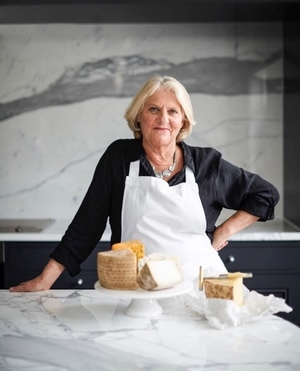 Juliet Harbutt – an authority on the history, cheesemaking styles and characteristics of the great cheeses of the world – loves to pass her knowledge on to others.
Juliet Harbutt – an authority on the history, cheesemaking styles and characteristics of the great cheeses of the world – loves to pass her knowledge on to others.
The ex-pat New Zealander, who has lived in the UK for 30 years and set up a very successful cheese shop in London, is currently here running a series of cheese tastings and classes through the School of Food and Wine in Auckland.
She has told Kathryn Ryan there are seven types of cheeses and a good cheeseboard should include around five, from different categories, shapes, textures, flavours and intensities.
Find out more about cheese on Radio Zealand.
Juliet Harbutt's Seven Categories Of Cheese
The character of a cheese can usually be judged by a glance at its cover or rind and an occasional squeeze. From this brief encounter you can learn to judge its texture, strength of flavour, basic character and, with a little practice, its maturity. Using the "rind'' method, you can categorise 99 per cent of all cheeses into one of the following.
Fresh Cheeses [no rind]
Examples: cream cheese, ricotta, feta, mozzarella
Only 1-15 days old without time to develop a rind and only a subtle "lactic'', fermenting fruit flavour with a hint of the green pastures. Often wrapped in chestnut leaves, rolled in ash or covered in herbs.
Aged Fresh Cheeses [grey-blue with wrinkly rinds]
Examples: chevrolait from Crescent Dairy and imported from the Loire Valley, from goat's milk: Crottin de Chavignol, pyramid, chabicou, coeur du Berry
Some fresh cheeses are left to drain and dry out gradually, developing a bluish-grey mould, a wrinkled rind and more pronounced flavour. These are most typically found in France and usually made with goat's milk.
Soft White [white fuzzy rind]
Examples: Camembert, Capricorn goat
The curd retains much of the whey, ensuring the cheese becomes soft and creamy and grows a white mould, penicillin candidum. Unpasteurised varieties develop a reddish-brown ferment on the rind whereas pasteurised versions are more 'Persil' white in appearance. Those made by adding cream to the milk are outrageously luxurious in taste and texture, such as explorateur, brillat savarin.
Semi-Soft [brown-orange to grey-brown]
Examples: Edam, Pont l'Eveque, young Gouda, Colby, Egmont
The moist curd is placed in moulds and lightly pressed to speed up draining. Various moulds develop, which are regularly brushed off building up a thickish rind, protecting the cheese and allowing it to mature. Some are "washed' creating an orange/ pink rind with a strong, piquant flavour and aroma, like langres, stinking bishop, epoisses and dirty devil.
Hard [thick, dense rind often waxed or oiled]
Examples: cheddar, Wensleydale, parmigiano reggiano
The curd is cut finely, then heated in vats before the whey is drained off. The curd is cut again or even "milled'' and piled on top of itself to remove even more of the whey - this process is called cheddaring. The curd is salted, packed in moulds lined with cheesecloth and firmly pressed.
Blue [gritty, rough, dry or sticky]
Examples: Stilton, Roquefort, Gorgonzola
The blue moulds, P. glaucum or P. Roqueforti are added to the milk but need oxygen to develop their colour. This is achieved by piercing the cheese with rods. The blue then grows along the tunnel, cracks and trails between the roughly packed curd.
Flavour Added [barely formed rind]
Examples: Stilton with apricots, Cornish Yarg, smoked cheddar
Hard cheeses to which ingredients are added to the curd or rubbed into the rind such as nuts, fruit, spices, herbs, hops and nettles; these include smoked cheeses. Blended cheeses are made by breaking up young cheeses, combining them with various sweet or savoury ingredients then re- forming them. A rapidly developing product, these offer an alternative for those who like dessert or who are not sure they like cheese

